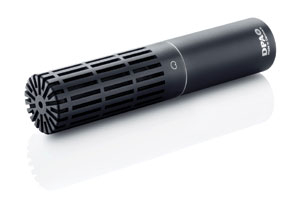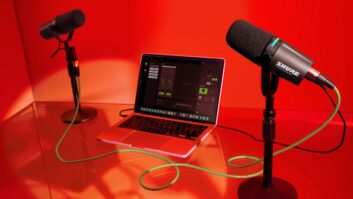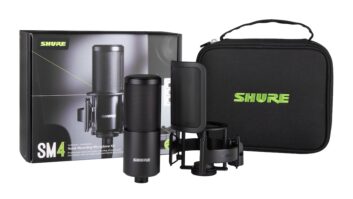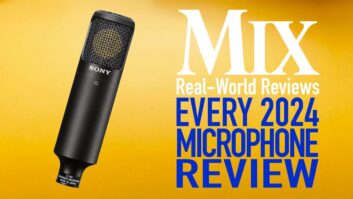
DPA Microphones is known for its high-performance, uncolored transducers for studio recording, broadcast and live performance. The 2011C is targeted at Live Sound users, but as we found out, it’s an able performer in the studio, as well. The mic handles an incredible 146dB SPL and has a small footprint due to the short MMP-C body. The mic is part of DPA’s Reference Standard group, meaning the capsule and body unscrew for easy integration with other DPA products, such as the higher-end MMP-A or MMP-B bodies, or the 4000 Series capsules. This is a system you can grow with.
The mic comes with a handy lyre shock-mount, and an optional stereo mount is also available. For this review I had a pair of the 2011Cs plus the stereo mount, which I’d highly recommend. It makes it incredibly easy to place and accurately aim the mics as a pair.
The technology in this capsule is something new and worth mentioning as it allows the mic to deftly reject the side and rear, yet still sound natural off-axis. From the outside, the look is odd—the mic appears to be a stubby shotgun. Inside, there are two separate capsules mounted back to back and integrated into a single front-address unit, instead of two diaphragms that share a single backplate, as seen in other side-address designs. Whatever is happening acoustically with this dual capsule—coupled with the ports on the side—does the trick: These mics sound great.
The front capsule is mounted at a considerable distance from the end of the mic, something my ears told me when I tried to place them end to end in an X/Y configuration: The center image was swimming all over the place. I called Bryce Boynton at DPA, and he gave me the lowdown about the capsules; that resulted in a non-intuitive move, so my X/Y was centered back from the end, which instantly fixed the problem. From then on, I knew not to cross the capsules at the end as you would with any other front-address pencil mic.
Top Performer
I used the mic on a range of sessions—first, around a drum kit. As an overhead stereo pair in X/Y, the 2011Cs rendered the kit beautifully. The stick on cymbals had a sweet woody ping with little hype at the top end, perfectly real and natural. I tried the mics on toms, too, which worked very well. Stick hits and transients were well rendered, and off-axis rejection of cymbals was very good, making the toms sit up in the mix. Next, I tried the 2011C outside a kick drum, which was a winner. Partnered with a Shure Beta 52 inside the kick, it gave me a great combination of tones to mix, giving the bottom end plenty of point and chest thump.
For many of these sessions I used the Moon 3500MP preamp (reviewed in Mix’s February 2013 issue), which offers an incredibly powerful and clean gain stage, even at extreme levels. This later became important when recording some finely detailed Foley work. While the footprint of the 2011C makes it easy to place anywhere, the dues owed for the 146 dB of SPL handling are that the mic has low output. For detail work at low SPL, you have to gas it quite a bit to get it to a decent level in your recorder. Even though the Moon was able to provide the clean gain necessary for this application, I would still use a mic with higher output in situations like these so you don’t have to fight the noise floor introduced with other less pristine preamps.
Next, I gave the pair to a trusted colleague who was recording acoustic guitar through an API Legacy Plus console. The 2011Cs were placed on two stands in front of the instrument with the bottom mic pointing just below the bridge, while the top mic pointed straight in at the fifth fret. Generally, when I hear mics placed this far apart on a guitar, one sounds much darker, requiring a move to tuck them in so the image left to right isn’t so stark. Even when placed this widely, it was remarkable how natural the instrument sounded. It’s a review cliché to say, “It was like the player was sitting in front of you,” but that is honestly how it sounded. It wasn’t too bright or boomy, and the image was hyper-real.
The pair was next employed for recording a small orchestral ensemble comprising a tuba, trumpets, saxophones and French horns. The A-rig for getting the room picture was a Decca tree on an AEA mount using three Blue Omni Mouse microphones. To see how they’d fare in this situation, the 2011Cs were placed behind the Decca tree in an ORTF pattern using the DPA stereo mount. The result was great by itself and even better when mixed with the tree. Again, the “reality” cliché comes to mind, but there’s no better way to describe it. The stereo picture was excellent, especially when blended with the omni microphones. The left to right and center image was very well defined, and the brass sounded, well, like brass—no hype at the top but just enough sparkle to make the horns pop.
I recorded a three-piece jazz ensemble for Mix’s Focusrite RedNet Series Webcast and used the 2011Cs on acoustic piano, mounted in an ORTF configuration using the stereo mount. The band was in tight quarters with the upright bass on the piano player’s right and the drummer just on the other side of the open lid. Again, I used the Moon 3500MP preamp and the piano sounded great. The rejection was remarkable, even though the players were close to each other. The piano sounded rich and natural, with beautiful transients when the player hit it hard and an even tone when he held chords—lovely.
How Was It?
The DPA 2011C is an excellent performer and excelled in a wide variety of applications. It sits well below the $1k range, and you can easily upgrade your setup by buying a higher-end DPA body, or another capsule or two. Its compact design and high-SPL handling make it perfect for use around a drum kit or guitar amp, or in other hot situations. The only downside is its low output, which means you’ll have to gain it up quite a bit for low-SPL detail work, which unveils the noise floor of your gain stage. Used as a pair in front of an instrument or ensemble, this mic has a knack for making the setting sound uncannily real. I experienced it on two separate occasions where I was drawn into the musical performance and forgot the tech—and that is priceless.
Kevin Becka is Mix’s technical editor.
PRODUCT SUMMARY
Company: DPA Microphones
Product: 2011C
Website:dpamicrophones.com
Price: $799
Pros: High-SPL handling, excellent rear and side rejection, sonically excellent.
Cons: Low output calls for excellent preamp in low-SPL use.
TRY THIS
With the optional DPA stereo bar, you can easily jump between ORTF and X/Y setups for different applications. I like using X/Y over a drum kit because the snare hits both capsules at the same time, resolving any phase issues you’d get from a spaced pair. Inside a piano, I like ORTF because I can accurately target the low and high end of the instrument, giving me a wider stereo picture if I need it, or I can pan in a bit to make the piano sit more toward the center of my mix.







